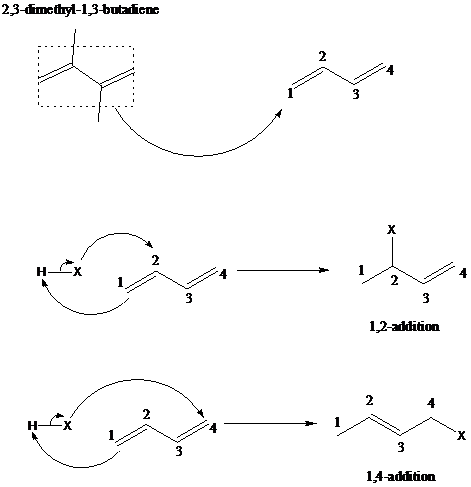
Concept explainers
Interpretation:
The reagents required to convert 2,3-dimethyl-1,3-butadiene to the given products are to be provided.
Concept introduction:
舧 Electrophiles are electron-deficient species, which has positive or partially positive charge. Lewis acids are electrophiles, which accept electron pair.
舧 Nucleophiles are electron-rich species, which has negative or partially negative charge. Lewis bases are nucleophiles, which donate electron pair.
舧 Free radical is an atom, molecule, or ion that has an unpaired electron, which makes it highly chemically reactive.
舧 Substitution reaction: A reaction in which one of the hydrogen atoms of a hydrocarbon or a functional group is substituted by any other functional group is called substitution reaction.
舧 Elimination reaction: A reaction in which two substituent groups are detached and a double bond is formed is called elimination reaction.
舧 Addition reaction: It is the reaction in which unsaturated bonds are converted to saturated molecules by the addition of molecules.
舧 The reaction in which there is addition of hydrogen molecule is called hydrogenation reaction.
舧
舧 Hydrogenation with platinum as a catalyst is used to convert unsaturated carbohydrates to saturated hydrocarbons
舧 Oxidation of
舧 Ozonolysis helps convert the carbon–carbon double bonds to carbon–oxygen double bond (carbonyl compounds).
舧 Dimethyl sulfide is used as a reducing agent that decomposes the intermediate formed into the carbonyl group.
舧 Alkenes react with bromine and form alkyl dihalides. The product stereochemistry is dependent on the stereochemistry of the reactant alkene.
舧 The 1,2 – addition of hydrohalogenation (HX) to a diene is the addition of hydrogen to the carbon designated as 1 and halogen to the carbon designated as 2. But the positions of carbons as 1 and 2 are not according to the IUPAC numbering of the molecule but as a conjugated diene. The mechanism is similar with 1,4-addition.
舧 The mechanism of 1,2 addition and 1,4-addition of hydrohalogenation is given below:

Want to see the full answer?
Check out a sample textbook solution
Chapter 13 Solutions
Organic Chemistry
- Compound A produce compound D while undergo Friedel Crafts Alkylation. Compound D is then oxidized and produce compound E (C11H12O3) as a major product.What are the possible structural formula of compound D and E?arrow_forwardCompound A, C3H7Br, does not react with cold dilute potassium permanganate solution. Upon treatment with potassium hydroxide in ethanol, A gives only product B, C3H6. Unlike A, B decolourises potassium permanganate solution. Ozonolysis of Bgives C, C2H4O, and D, CH2O. Suggest the structural formulae of A, B, C and D.Write the equations for all the reactions involved.arrow_forwardProvide the structure of the major organic product in the substitution reaction of 3-iodocyclopentene with water.arrow_forward
- On being heated with a solution of sodium ethoxide in ethanol, compound A (C7H15Br) produced a mixture of two alkenes B and C, each of which had the molecular formula C7H14. Catalytic hydrogenation of major isomer B or minor isomer C gave only 3-ethylpentane. Suggest structures and mechanisms for compounds A, B, and C consistent with these observations.arrow_forwardStarting with acid chloride with exactly 5 carbon atoms, and using appropriate reagents outline the synthesis of the following molecules:arrow_forwardCompound A is an alcohol that undergoes oxidation to produce compound B.Compound B is a ketone that gives positive triiodomethane reaction. Compound B isthen reacted with phenyl magnesium bromide, C6H5MgBr in the presence of aqueousacid to form compound C. Compound C has the molecular formula of C9H12O. Deducethe structure for compound A, B and C. PLEASE PROVIDE CLEAR DRAWINGS AND EXPLANATIONSarrow_forward
- Friedel–Crafts alkylation of benzene with (R)-2-chlorobutane and AlCl3 affords sec-butylbenzene. Would you expect the product to exhibit optical activity? Explain, with reference to the mechanism.arrow_forwardThe following equation shows the bromination of compound 1. Propose a structure for product D and a curved arrow mechanism that accounts for its formation featuring the initiation, propagation and termination steps. can you also discuss the stereochemical outcome.arrow_forwardCompound A(C10H12O)gives off oxygen on treatment with sodium metal and also decolorizes Br2 in CCl4 to give organic compound B. Compound A on treatment with I2 in NaOH gives iodoform and salt C which after acidification gives a white solid D(C7H6O2). Using knowledge of organic chemistry identify structures A,B,C and Darrow_forward
- Wolff-Kishner reduction of compound W gave compound A. Treatment of A with m-chloroperbenzoic acid gave B which on reduction with LiAH4 gave C. Oxidation of compound C with chromic acid gave D (C9H14O). Suggest the structures for A, B, C, and D.arrow_forward1,2,3,4,5-Pentafluoro-6-nitrobenzene reacts readily with sodium methoxide in methanol at room temperature to yield two major products, each having the molecular formula C7H3F4NO3. Suggest reasonable structures for these two compounds.arrow_forwardCompound A is first treated with ylide Y and then reacted with Rh and hydrogen gas. Using the spectroscopic data provided, what is the structure of Compound A?arrow_forward
